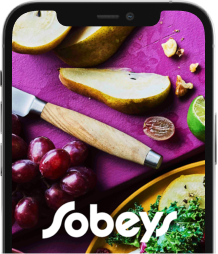Variety is the spice of life and an essential part of a balanced diet. We’ve compiled a selection of our favourite superfoods that we know you’ll love as much as we do. “Superfoods are foods that are nutrient-dense,” explains registered dietitian Kristy Hogger. “They contain significant levels of plant compounds called phytochemicals, which may provide health benefits or reduce the risk of disease.”
Eggs
Get cracking with these portable, protein-packed gems
Fried, poached, scrambled or baked – eggs are the star of quick-cooking, last-minute meals. “All eggs are a good source of high-quality protein,” says Hogger. “A large egg contains approximately 6 g of protein.” Add a sliced hard-boiled egg to your next work lunch salad for a protein boost. For a speedy weeknight meal, top a kale and quinoa salad with a poached egg or toss leftover rice with scrambled eggs and veggies.
Nuts
Add crunch to anything with these toasty little treats
Grab a handful as a snack or toss some on your yogourt or salad for added richness and crunch. According to Hogger: “Nuts are high in fat, but the fats are mostly unsaturated, called monounsaturated and polyunsaturated fats. These types of fats are beneficial and may help to reduce the risk for heart disease.” Try buying raw nuts and toasting them yourself. For added bulk in your breakfast, top steel-cut oats with a 1/4 cup (60 mL) of nuts and seeds.
Quinoa
This grain has a nutty and mildly earthy flavour
Small, round and springy in texture, quinoa is a great whole grain choice and is a nice substitute for rice or pasta. It is higher in protein than most grains and is considered a complete protein, meaning it contains all essential amino acids. It’s also gluten-free. Enjoy quinoa as a base for salad or with curries and stews.
Salmon
The rich flavour makes this fish a crowd pleaser
Fresh or smoked, preserved or grilled, for brunch or for dinner – salmon is loved any time and in many ways. “A serving (75 g) of cooked salmon is a good source of omega-3 fatty acids,” says Hogger. “Salmon contains EPA and DHA, the omega-3s found in fatty fish that have shown to lower risk for heart disease and stroke, decrease blood pressure, and help prevent arthritis by helping to reduce inflammation.” To reap the benefits associated with omega-3s, Canada’s Food Guide recommends eating at least two servings of fish per week.
Beans
Budget-friendly and endlessly versatile – legumes are a pantry winner
Tender and meaty, beans add substance and texture to soups, stews and chilies. According to Hogger, “[Beans] provide protein and a significant amount of fibre, in addition to other nutrients found in meat, such as iron, zinc, B vitamins and magnesium. Canada’s Food Guide suggests that people regularly choose beans and other meat alternatives, such as lentils and tofu in order to reduce the amount of saturated fat in their diet.” Intrigued? Try making your own hummus at home.
Pomegranates
Crack one open to release the ruby-red jewels
Sweet-tart juice bursts from the thick-skinned pomegranate’s seeds as they pop in your mouth. This fruit is a source of potassium and vitamin C, which supports healthy teeth, bones and gums. Use pomegranate seeds in cocktails and salads for extra sparkle.
Tomatoes
The flavour-packed stars of our favourite dishes
Firm-fleshed with a paper-thin skin and edible seeds, ripe tomatoes burst with intense, tangy flavour. They’re delicious raw, or as the base of cooked stews and sauces. Tomato sauces and purées are a source of the antioxidant lycopene, vitamin C and potassium. “Research suggests that eating lycopene-rich foods may reduce risk of cancer, heart disease and age-related eye disorders,” says Hogger.
Cherries
Snack on this plump, juicy and intensely sweet stone fruit
You get a heady burst of sweetness when you sink your teeth into lush cherries. These deep-red gems add rich flavour to desserts and make a surprisingly delicious garnish on a cheese plate. Cherries are a source of potassium, which may lower blood pressure. They’re also a source of fibre and magnesium, which is said to boost metabolism.
Butternut Squash
A sweet-tasting gourd that stores well in the pantry
It’s not just for Halloween and Thanksgiving – you can enjoy the mildly sweet flavour of butternut squash year round. Roast the bright orange insides to bring out their nutty sweetness, or add diced squash to a comforting stew for a cozy one-pot dinner. Eat squash for its potassium, which may reduce the risk of high blood pressure, and beta carotene, which has been linked to cancer prevention. “Butternut squash is a rich source of vitamin A, a vitamin that many Canadians are lacking,” says Hogger. “In fact, 1 cup (250 mL) of cooked butternut squash provides more than 100% of our daily vitamin A requirement. Canada’s Food Guide recommends that we eat at least one orange vegetable each day, and butternut squash is a great choice.”
Tangerines
Eat this sweet citrus as a peel-and-go snack
Every segment of a tangerine is bursting with tangy juice. Use tangerines in salads or toss them together with crunchy leafy greens, nuts and your favourite salad dressing. They’re a fun partner for sharp cheeses, too. Or pack a few in your bag to munch while you’re out and about. Tangerines are high in vitamin C, which helps support healthy teeth, bones and skin.
Carrots
Chomp on this super-crunchy root veggie
Sweet, earthy and satisfyingly crisp, carrots bring family-friendly flavour and vibrant colour to the table. Roasted, sautéed, steamed or raw: There are multiple ways to serve up these humble, good-for-you roots. They’re high in vitamin A and one of the richest dietary sources of beta carotene, which is good news for your bones, teeth and eyes.
Yellow Peppers
Add colour to stir-fries with this crispy veg
We know the yellow pepper is technically a fruit, but it’s best served in green salads or savoury dishes. Try it diced in salsa, stuffed with grains and baked, or sliced for a crudités platter. Peppers are high in vitamin C and are a source of potassium, a mineral that’s linked to a reduced risk of stroke and heart disease.
Lemons
Kick up everyday dishes with a squeeze of this super-sour citrus
Lemon packs a pucker-worthy punch in everything from soft drinks to cheesecake. Slice one into wedges to flavour white fish or a classic cocktail. We like whisking fresh lemon juice with olive oil for a quick salad dressing. Lemons are rich in vitamin C, a dietary antioxidant that’s essential to bone, tooth and gum health.
Peas
These tiny green gems pop with mild sweetness
Starchy, comforting and fun to pile on your fork, peas are the side-dish soul mates of mashed potatoes and meat pies or fried fish. Toss them into stir-fries, or simply eat them fresh from the pod. They’re a source of eyesight-supporting beta carotene, as well as potassium, a mineral linked to a reduced risk of high blood pressure.
Kale
A leafy-green nutritional powerhouse
Kale is the rugged, crimp-leafed cousin of the cabbage. Serve it up raw or steamed, or as the star ingredient in your green smoothies or juice. Tip: Before serving it in a salad, give the leaves a good massage with dressing to soften the texture . Kale is a source of beta carotene, potassium, vitamin K and vitamin A. In addition to those nutrients and vitamins, kale is a source of “antioxidants which are associated with reduced risk of cancer,” says Hogger.
Lime
This feisty citrus adds bite to sweet and savoury dishes
Lime juice and zest add tangy punch to a variety of dishes, including juices, cakes and pitcher drinks. Lime wheels make a pretty garnish, too—try mixing them with orange and lemon slices to pep up plain water. This fruit is a source of vitamin C, an antioxidant.
Blueberries
Toss these deep-blue jewels in your yogourt or cereal
Blueberries are little balls of sweet-tart goodness—both in taste and health benefits. Blitz and blend them into smoothies, or add them to pancakes and spinach salads for a pop of colour. We snack on a handful when we’re feeling peckish for a treat that’s also a source of fibre. “The blue colour of blueberries is a result of anthocyanins, a type of antioxidant,” says Hogger. “Studies have shown many health benefits associated with consumption of anthocyanins, including improved vision, reduced risk for cancer and heart disease, and prevention of age-related declines in cognitive function.”
Prunes
These sweet, sticky treats are also guilt-free
Prunes are actually dried plums. They’re plump, chewy and most at home in fruitcake, oatmeal, stuffings and lamb dishes. Not only do they add a decadent richness, but they also provide nutrients such as potassium, magnesium, phosphorous and beta carotene.
Eggplant
A mildly smoky flavour that tastes dreamy in dips
Underneath their gorgeous deep-purple skins, eggplants are spongy and filled with tiny seeds. Best baked or pan-fried, these relatives of the potato love to be paired with Parmesan, goat cheese and tomatoes. Eggplants are a source of potassium, which may help lower blood pressure, and they’re low in sodium, too.








